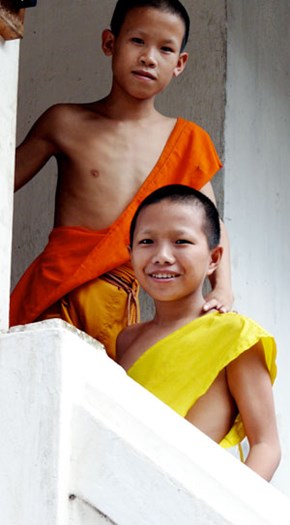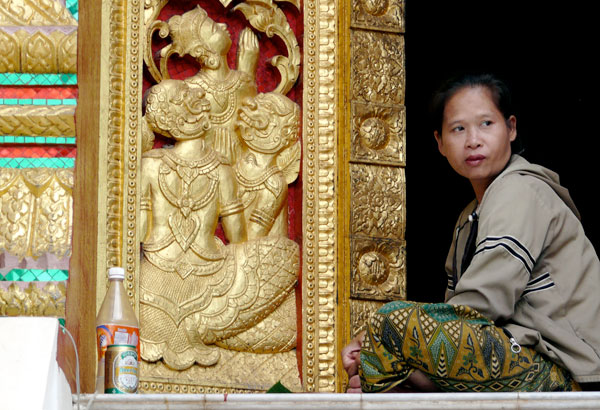LUANG PRABANG, LAOS - The first thing that strikes you about this city is that there are no traffic lights - mainly because there is very little traffic. Quaint Luang Prabang, a 16th century city, appears frozen in time – a peaceful place where ox and motorscooters hog the road.
There are other striking features that set this city, nestled in the majestic mountains and lush jungle of central Laos, apart from other Indochina cities. Like the army of monks who regularly patrol its dusty streets wrapped in their striking orange robes, and the giggling children, who run up to strangers and greet them with songs.
"So what are they singing?" a member of our visiting group asked Kip, our local guide who suddenly became quiet and tried to divert our attention to other matters.
When we insisted to know, she shyly replied: "The song begins 'big nose foreigners ...' but they do not mean disrespect," she quickly interjected, "it's just that the children are fascinated by Caucasians' looks."
The group erupted in laughter and no one appeared offended as we continue to follow Kip on a journey that introduced us to this fascinating city of40,000 which was designated a World Heritage Site by the United Nations in 1995.
In some ways, Laos, and particularly Luang Prabang, are the perfect 21st century destinations - virtually no pollution and an undisturbed eco-system that features an abundance of wildlife ranging from tigers and elephants to poisonous spiders.
This is Al Gore's kind of country.
For the most part, though, Laos has been the afterthought of tourism. North American and European operators offer it only as an add-on to more popular tours to Vietnam, Thailand and Cambodia.
"Laos is still very much undeveloped, especially when it comes to tourism," Anthony Dupont, a tour operator based in Thailand, told us. "However, that's changing quickly and many people are now asking our company to include Laos as part of their Indochina itinerary."
That's resulted in an 80 per cent increase in tourism to Laos over the past two years. And that's good news for this desperately poor country that now appears stable under a socialist regime which embraces tourism as a way of attracting much-needed foreign currency.
"Tourism is Laos' No. 1 industry now," said Dupont, an Englishman who now calls Bangkok home.
Backpackers have long known of Laos' many charms. They've been coming here for decades to trek through the lush jungles and have enjoyed quaint cities like Luang Prabang, where they stay in attractive and inexpensive colonial guest houses and sip Laos' famed coffee in Paris-style cafes - both holdovers from France's Indochina reign.
But more and more luxury chains, like Orient Express - the famed European train and hotel company - are beginning to set up shop in Laos (Orient Express owns the 5-star La Residence Phou Vao property in Luang Prabang) and are attracting traditional and high-end travelers and much-needed employment to this country where salaries average $33 U.S. a month.
When they get here, visitors are awed by the natural beauty and fascinating history offered in Luang Prabang, especially its 32 ancient temples that are still filled to capacity with young monks.


Left: Poor families send their kids to temples for education. Right: A woman guards a gold statue.
"These temples serve as a living history," said our guide Kip. "What you see here now is what took place in ancient temples like Angkor Wat (Cambodia's historic relic) many hundreds of years ago
"The young men are sent here by poor families so they can get a good education and return home to improve lives in their villages."
The monks are eager to engage visitors with the hope of improving their language skills.
"You are from where, please?" asks one shaven monk in broken English at the 16th century Wat Xieng Thong, one of the city's perfectly-preserved temples featuring golden buildings with stunning glass mosaic walls.
No one is sure how many monks actually live in Luang Prabang but Kip estimates there's thousands and said if we'd like to meet some of them, "be up at 5:30 tomorrow morning and I will take you to see the monks' daily morning alms offering (it starts at 6 a.m.) on the main street (Sisavangvong Road)."
The offer was too tempting to resist so through blurry eyes and the dusk of dawn the next morning, we purchased some sticky rice, bananas and candy - all part of the monks' daily diet - from a street vendor and joined the long line of locals and tourists waiting on Sisavangvong Road to give the food offerings to the holy men.
The alms offering has become a must-do on a tourist's agenda while in Luang Prabang and is just one of many interesting things you can enjoy here. In fact, there are enough attractions in this little city to keep you busy for two or three days before heading to other parts of Laos, like the capital, Vientiane, 200 kilometres due south.
A visit to the 18th-century Vat That Chomsi Temple, which sits atop Mount Phousy in the middle of town, is a must for any visitor but be prepared; it takes a strong will and even stronger legs to reach the summit, over 400 steps away. And no, there are no elevators.
The Chomsi Temple is also illuminated at night and acts as a beacon for the very religious townspeople. Day trips from Luang Prabang include visits to the Tad Kuang Si waterfall, 28 kilometres away, one of Asia's most spectacular cascades, and there's also plenty of trekking, cycling, canoeing and elephant rides in the area to be enjoyed.
NOTE: The best way to reach Laos is through Bangkok on Bangkok Airways, which offers several daily flights to Luang Prabang from the Thai capital. Laos Airways offers flights within the country.
About the Author
Marc Atchison is a veteran journalist and a seasoned traveller with more than 20 years of travel writing experience. As the former Travel Editor of the Toronto Star, Canada's largest newspaper, and now Editor-in-Chief and Senior Writer for TraveLife magazine (Canada) and travelife.ca, Marc has been to over 100 countries in the world. Japan is one of his favorite destinations and he's been there on numerous occasions.